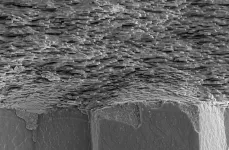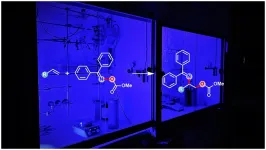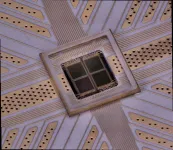(Press-News.org) Scientists have long been aware of the dangerous overuse of antibiotics and the increasing number of antibiotic-resistant microbes that have resulted. While over-prescription of antibiotics for medicinal use has unsettling implications for human health, so too does the increasing presence of antibiotics in the natural environment. The latter may stem from the improper disposal of medicines, but also from the biotechnology field, which has depended on antibiotics as a selection device in the lab.
"In biotech, we have for a long time relied on antibiotic and chemical selections to kill cells that we don't want to grow," said UC Santa Barbara chemical engineer Michelle O'Malley. "If we have a genetically engineered cell and want to get only that cell to grow among a population of cells, we give it an antibiotic resistance gene. The introduction of an antibiotic will kill all the cells that are not genetically engineered and allow only the ones we want -- the genetically modified organisms [GMOs] -- to survive. However, many organisms have evolved the means to get around our antibiotics, and they are a growing problem in both the biotech world and in the natural environment. The issue of antibiotic resistance is a grand challenge of our time, one that is only growing in its importance."
Further, GMOs come with a containment issue. "If that GMO were to get out of the lab and successfully replicate in the environment, you could not predict what traits it would introduce into the natural biological world," O'Malley explained. "With the advent of synthetic biology, there is increasingly a risk that things we're engineering in the lab could escape and proliferate into ecosystems where they don't belong."
Now, research conducted in O'Malley's lab and published in the journal Nature Communications describes a simple method to address both the overuse of antibiotics, as well as containment of GMOs. It calls for replacing antibiotics in the lab with fluoride.
O'Malley described fluoride as "a pretty benign chemical that is abundant in the world, including in groundwater." But, she notes, it is also toxic to microorganisms, which have evolved a gene that encodes a fluoride exporter that protects cells by removing fluoride encountered in the natural environment.
The paper describes a process developed by Justin Yoo, a former graduate student researcher in O'Malley's lab. It uses a common technique called homologous recombination to render non-functional the gene in a GMO that encodes a fluoride exporter, so the cell can no longer produce it. Such a cell would still thrive in the lab, where fluoride-free distilled water is normally used, but if it escaped into the natural environment, it would die as soon as it encountered fluoride, thus preventing propagation.
Prior to this research, Yoo was collaborating with the paper's co-author Susanna Seppala, a project scientist in O'Malley's lab, in an effort to use yeast to characterize fluoride transport proteins that Seppala had identified in anaerobic fungi. A first step in this project was for Yoo to remove native yeast fluoride transporters.
Shortly after generating the knockout yeast strain, Yoo attended a synthetic biology conference where he heard a talk on a novel biocontainment mechanism intended to prevent genetically modified E. coli bacteria from escaping lab environments. At that talk, he recalled, "I realized that the knockout yeast strain I had generated could potentially act as an effective biocontainment platform for yeast."
"Essentially, what Justin did was to create a series of DNA instructions you can give to cells that will enable them to survive when fluoride is around," O'Malley said. "Normally, if I wanted to select for a genetically engineered cell in the lab, I'd make a plasmid [a genetic structure in a cell, typically a small circular DNA strand, that can replicate independently of the chromosomes] that had an antibiotic resistance marker so that it would survive if an antibiotic was around. Justin is replacing that with the gene for these fluoride exporters."
The method, which O'Malley characterized as "low-hanging fruit -- Justin did all of these studies in about a month," also addresses a simple economic limitation to antibiotic-driven cell selection in biotechnology labs. Aside from fueling the rise of resistant strains of bacteria, she continued, "from a biotech standpoint, the process of creating antibiotic-resistant organisms is also pretty darn expensive. If you were going to run a ten-thousand-liter fermentation, and it may cost you thousands of dollars per fermentation to add some antibiotics, that's a crazy amount of money." Notably, using fluoride at a low concentration would cost only about four cents per liter.
Clearly, said Seppala, "we'd much rather use a chemical like fluoride that's relatively benign, abundant and cheap, and can be used to do the same thing that is achieved using a conventional antibiotic."
Yoo explained that the role of the fluoride transporters had only recently been elucidated, in 2013, when this project began. Emerging approaches to implementing biocontainment have focused on using biological parts that are foreign to the organism of interest, shifting focus toward what Yoo described as "brilliant, yet complex, systems," while perhaps diverting attention from this simpler approach.
INFORMATION:
Following the repeal of the short-lived Cook County, Illinois Sweetened Beverage Tax, sales of sweetened beverages went right back to where they were before the tax went into place, according to a new study led by researchers at the University of Illinois Chicago. The study is published in JAMA Network Open.
The tax, which included both sugar-sweetened and artificially-sweetened diet beverages, was largely pitched as a way to reduce county budget deficits. The tax lasted just four months -- it went into effect on Aug. 2, 2017 and ended on Dec. 1, 2017.
"We ...
Mollusks build shells to protect their soft tissues from predators. Nacre, also known as the mother of pearl, has an intricate, highly regular structure that makes it an incredibly strong material. Depending on the species, nacres can reach tens of centimeters in length. No matter the size, each nacre is built from materials deposited by a multitude of single cells at multiple different locations at the same time. How exactly this highly periodic and uniform structure emerges from the initial disorder was unknown until now.
Nacre formation starts uncoordinated ...
Drones, robots and autonomous systems can transform the natural world in and around cities for people and wildlife.
International research, involving over 170 experts and led by the University of Leeds, assessed the opportunities and challenges that this cutting-edge technology could have for urban nature and green spaces.
The researchers highlighted opportunities to improve how we monitor nature, such as identifying emerging pests and ensuring plants are cared for, and helping people engage with and appreciate the natural world around them.
As robotics, autonomous vehicles and drones become more widely used across cities, pollution and traffic ...
What The Study Did: In this observational study of 5,256 U.S. nursing home residents with COVID-19, increased age, male sex and impaired cognitive and physical function were independent risk factors for all-cause 30-day mortality.
Authors: Orestis A. Panagiotou, M.D., Ph.D., of the Brown University School of Public Health in Providence, Rhode Island, is the corresponding author.
To access the embargoed study: Visit our For The Media website at this link https://media.jamanetwork.com/
(doi:10.1001/jamainternmed.2020.7968)
Editor's Note: The article includes conflict of interest and funding/support disclosures. Please see the article for additional information, ...
What The Study Did: The findings of a survey study using data from California suggests the COVID-19 pandemic was associated with increases in self-reported worry about violence for oneself and others, increased firearm acquisition and changes in firearm storage practices.
Authors: Nicole Kravitz-Wirtz, Ph.D., M.P.H., University of California Firearm Violence Research Center and Violence Prevention Research Program, Department of Emergency Medicine, University of California Davis School of Medicine in Sacramento, is the corresponding ...
Whether in beta-blockers to treat high blood pressure or in natural products: So-called vicinal aminoalcohols are high-quality organic compounds that are found in many everyday products. However, their production is difficult. For a long time, chemists are trying to develop efficient methods of synthesizing them. In their recent study published in the journal Nature Catalysis, scientists led by Prof. Dr. Frank Glorius of Münster University have found a solution for the production of a special variant of aminoalcohols. "The new method helps to study the properties of the substance and to find applications for these ...
Assembling tiny chips into unique programmable surfaces, Princeton researchers have created a key component toward unlocking a communications band that promises to dramatically increase the amount data wireless systems can transmit.
The programmable surface, called a metasurface, allows engineers to control and focus transmissions in the terahertz band of the electromagnetic spectrum. Terahertz, a frequency range located between microwaves and infrared light, can transit much more data than current, radio-based wireless systems. With fifth generation (5G) communications systems offering speeds 10 to 100 times faster than the previous generation, demand for bandwidth is ever increasing. Facing the emergence of technologies such as self-driving cars and augmented reality ...
What The Study Did: Changes were assessed in abortions performed and at what gestational age following a Texas order postponing nonmedically necessary surgeries due to the COVID-19 pandemic compared with abortions performed during the same months in 2019.
Authors: Kari White, Ph.D., M.P.H., of the University of Texas at Austin, is the corresponding author.
To access the embargoed study: Visit our For The Media website at this link https://media.jamanetwork.com/
(doi:10.1001/jama.2020.24096)
Editor's Note: The articles includes conflict of interest and funding/support ...
What The Viewpoint Says: The rapid spread of scientific misinformation on social media platforms throughout the COVID-19 pandemic is discussed in this Viewpoint, which also proposes strategies to counteract its adverse effects including surveillance of digital data and partnering with trusted messengers to engage the public and advance scientifically sound public health measures.
Authors: Raina M. Merchant, M.D., M.S.H.P., of the University of Pennsylvania in Philadelphia, is the corresponding author.
To access the embargoed study: Visit our For The Media website at this link https://media.jamanetwork.com/
(doi:10.1001/jama.2020.24514)
Editor's Note: The ...
ITHACA, N.Y. - From an observatory high above Chile's Atacama Desert, astronomers have taken a new look at the oldest light in the universe.
Their observations, plus a bit of cosmic geometry, suggest that the universe is 13.77 billion years old - give or take 40 million years. A Cornell University researcher co-authored one of two papers about the findings, which add a fresh twist to an ongoing debate in the astrophysics community.
The new estimate, using data gathered at the National Science Foundation's Atacama Cosmology Telescope (ACT), matches the one provided by the standard ...



